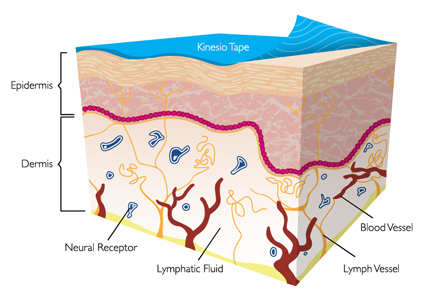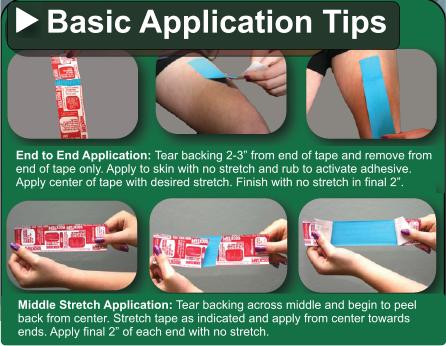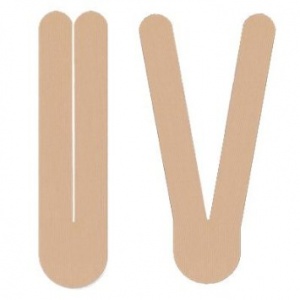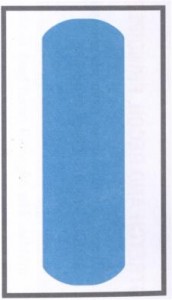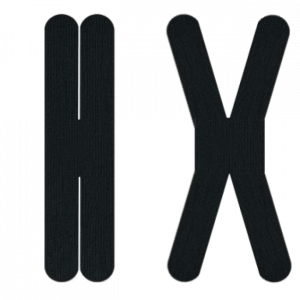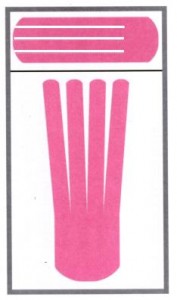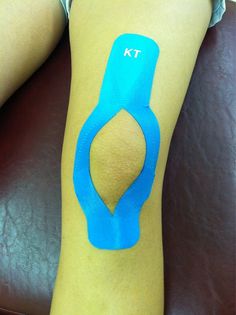Kinesio Taping
Original Editor - Karina Leahy
Top Contributors - Karina Leahy, Ewa Jaraczewska, Vanessa Rhule, Admin, Kim Jackson, Candace Goh, Shaimaa Eldib, Wanda van Niekerk, Naomi O'Reilly, George Prudden and WikiSysop
Introduction[edit | edit source]
Kinesio Taping Method is a therapeutic tool utilised by the rehabilitation specialists in all programs (paediatric,[1] geriatric, orthopaedic,[2] neurological, oncology and others) and levels of care (acute care,[3] inpatient rehabilitation,[4] outpatient, home care and Day Rehab). The idea of using elastic tape to mimic the therapist's hands was first presented by Dr. Kenzo Kase in the 1970's. Since then it became the modality used in pain management[5], soft tissue injury[6], tissues and joints malalignment[1], oedema[7], and more. Kinesio Taping Method utilises four types of Kinesio Tex Tapes, each one with specific properties designed to use on fragile skin, sensitive skin or applied with higher tensions. Kinesio Taping Method has also been found effective in treating animals[8] and two special tapes are used: Kinesio Equine and Kinesio Canine.
Properties[edit | edit source]
Kinesio Tex Tape is manufactured from in the US pre-stretched by 15-25% as it is applied to the backing paper. It is characterised by the ability to stretch to 120-140% of its original length and, following application, recoil back towards its unstretched length. KT purportedly mimics the physical qualities of the skin as it is believed to be the same weight and thickness of the epidermis along with its inherent elastic properties[9]. It is comprised of polymer elastic wrapped in 100% cotton fibres, which allows for evaporation of moisture. The glue is heat-activated and is applied in a wave-like pattern to mimic the qualities of the fingerprint on the finger tip. KT is both waterproof and breathable and it can be worn during exercise, showering and even swimming. It dries quickly and seldom causes skin irritation, however; if skin irritation does occur, advise patient to remove tape immediately and wash the area with warm soapy water to remove any residual adhesive. When properly applied, it will last up to 3-5 days.
Theory[edit | edit source]
The type of application theoretically determines the physiological outcome: for example, KT is applied unstretched over manually stretched skin above the injured muscle. This type of application will cause the skin to form convolutions which lift the skin[6]. Theories suggest that these convolutions encourage regeneration of injured tissue by increasing interstitial space and alleviating interstitial pressures which occur from swelling post injury[10]. This decrease in pressure also decompresses subcutaneous nociceptors, leading to decreased pain[6]. It is also theorised that lifting the skin detaches filaments which attach the skin to endothelial cells of the lymphatic and capillary beds. This is proposed to to create channels which allows for lymph to drain, thus reducing swelling and allowing increased blood flow to the area[11]. The evidence for these theories is still in its infancy and requires extensive research.
Basics of Application[edit | edit source]
- Ensure to thoroughly assess the patient in order to identify the most appropriate application
- Do NOT apply tape to any area of skin that is damaged by: scrapes; cuts; burns; sunburn or any type of skin rash/irritation
- Skin should be free of oils and lotion prior to application
- If body hair is limiting adhesion you may need to trim or shave the area
- Do NOT apply with excess tension (as with zinc oxide application)
- If patient has been exercising, ensure perspiration has completely stopped before application
- If you are using a roll of tape, measure and cut carefully
- Round all the edges of the tape to prevent premature peeling
- Avoid touching the adhesive side of the tape after removing the backing as this may decrease the adhesive strength on the skin
- Once the tape is applied, activate the heat sensitive glue by rubbing up and down the surface of the tape
- Wait at least 1 hour after application before engaging in activity that causes sweating
- Do not swim or shower for at least 1 hour after application
- To dry the tape after exercising, swimming or a shower, pat gently with a towel
Contra-indications and Precautions[edit | edit source]
- Malignancy
- Infection, cellulitis
- Open wound
- DVT
Precautions:
- Diabetes
- Congestive heart failure
- Fracture
Different Types of Application[edit | edit source]
KT can be applied in the shape of a 'Y', 'I', 'X', 'Fan', 'Web' or 'Donut'. The shape selection depends on the the size of the affected muscle and the result you are trying to achieve.
'Y' tape application is generally used to:[edit | edit source]
- Surround the target muscle
- Inhibit or facilitate muscle stimuli
- Should be 2 inches longer than the target muscle
'I' tape application is generally used for:[edit | edit source]
- Acute injuries in place of 'Y' tape
- Oedema and pain (primary purpose)
- Alignment correction
'X' tape application is generally used when:[edit | edit source]
- The origin and insertion of the target muscle change depending on movement e.g. the Rhomboids
'Fan/Web' tape application is used for:[edit | edit source]
- Oedema (web is different because the ends remain intact)
'Donut' tape application is generally used for:[edit | edit source]
- Oedema (use overlapping strips and the center is cut out over the area of focus)
[edit | edit source]
Insertion to Origin: [edit | edit source]
- Used to inhibit overused or stretched muscles
- Light stretch used to achieve goal
Origin to Insertion:[edit | edit source]
- Used to facilitate weak or underperforming muscles
- Light to moderate stretch required
Type of Application Stretch[edit | edit source]
The target muscle should be elongated prior to stretch. KT requires none to partial stretch to be applied on tape.
- Full - 100%
- Severe - 75%
- Moderate - 50%
- Light - 15-25%
- None - 0%
For percentage stretch refer to percentage of available stretch.
Line of pull of the tape is key
- Facilitate: proximal to distal (15-50% tension)
- Inhibit: distal to proximal (15-25%) [13]
Kinesio Tape Instruction Video's[edit | edit source]
http://www.kinesiotaping.hk/how-to-use-Kinesio-Tapes.html[14]
Clinical Implications[edit | edit source]
- Level of evidence - weak
- What does the evidence support?
-Increase ROM
-Increase in Function
-Decrease Oedema/Swelling
Pros[edit | edit source]
- Some evidence proves theories
- Provides a treatment
- Applicable to multiple patient populations
- Feeling of treatment encourages movement
- Versatile
Cons[edit | edit source]
- Small body of evidence to prove theories
- Expensive
- Requires practice
- Skin irritation
Patient After-Care Advice[edit | edit source]
- If the tape makes symptoms worse then take it off
- If the tape starts to come off then rub it to re-activate the tape adhesive
- Do NOT dry it with a hairdryer
References[edit | edit source]
- ↑ 1.0 1.1 Dixit J, Roy S.Effect of Neuromuscular Taping Along with Reactive Postural Adjustment and Anticipatory Postural Adjustment in Improving Sitting Balance in Children with Spastic Diplegic Cerebral Palsy. IJHSR 2018;8(11):116-125.
- ↑ Arrebola LS, Teixeira de Carvalho R, Yan Lam Wun P, Rizzi de Oliveira P, Firmo dos Santos J, Gonçalves Coutinho de Oliveira V, Pinfildi CE. Investigation of different application techniques for Kinesio Taping® with an accompanying exercise protocol for improvement of pain and functionality in patients with patellofemoral pain syndrome: A pilot study. Journal of Bodywork and Movement Therapies 2020, 24 (1):47-55,
- ↑ Brockmann R, Klein HM. Pain-diminishing effects of Kinesio® taping after median sternotomy. Physiotherapy Theory and Practice 2018; 34(6): 433-441.
- ↑ Gallagher J. Anterior and posterior diaphragm kinesio taping for intractable hiccups after ischemic stroke: A case report. Medicine (Baltimore). 2018 Aug;97(34):e11934.
- ↑ Donec V, Kubilius R. The effectiveness of Kinesio Taping® for pain management in knee osteoarthritis: a randomized, double-blind, controlled clinical trial. Ther Adv Musculoskelet Dis. 2019 Aug 29;11:1759720X19869135.
- ↑ 6.0 6.1 6.2 Wang CK, Fang YD, Lin LC, Lin CF, Kuo LC, Chiu FM, Chen CH. Magnetic Resonance Elastography in the Assessment of Acute Effects of Kinesio Taping on Lumbar Paraspinal Muscles. J Magn Reson Imaging. 2019 Apr;49(4):1039-1045.
- ↑ Tantawy SA, Abdelbasset WK, Nambi G, Kamel DM. Comparative Study Between the Effects of Kinesio Taping and Pressure Garment on Secondary Upper Extremity Lymphedema and Quality of Life Following Mastectomy: A Randomized Controlled Trial. Integrative Cancer Therapies. January 2019.
- ↑ Wójcik M. The Use of Physical Therapy Procedures in the Treatment of Soft Tissue Injuries in a Horse: A Case Study. J Vet Sci Med Diagn 2017; 6:4.
- ↑ Kase K. Clinical therapeutic application of the kinesio taping method. Ken-i Kai Information 2003
- ↑ Hammer WI. Functional soft tissue examination and treatment by manual methods. 3rd ed. Boston: Jones and Bartlett Publishers, 2006
- ↑ Lipinska A, Sliwinski Z,Kiebzak W, Senderek T, Kirenko J. Influence of kinesiotaping application on lymphoedema of an upper limb in women after mastectomy. Polish Journal of Physiotherapy 2007:7;258-269.
- ↑ United States Food and Drug Administration (FDA). http://www.theratape.com (accessed 13 June 2013).
- ↑ 13.0 13.1 Kaze K, Wallis J, Kaze T. Clinical therapeutic applications of the kinesio taping method. Tokyo: Japan, 2003.
- ↑ Kinesio Taping Association International. Kinesio HK:The original from Dr. Kenzo Kaze since 1979. http://www.kinesiotaping.hk/how-to-use-Kinesio-Tapes.html (accessed 13 June 2013).
